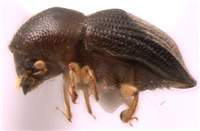Diagnosis
Elytral declivity extremely flat and broad, especially laterally. Covered with minute star-shaped scales. Pronotum elongated, from dorsal aspect conical. Tibiae narrow, with fewer than 6 denticles.
Distribution
From India to Oceania, in most places very common.
Biology
No host specificity known, except prefers large and humid logs. Often collected from soil.
Taxonomy
Most currently described species are likely synonyms of L. sordicauda.
Detailed description
Eyes shallowly emarginate, upper part smaller than lower part. Antennal club approximately circular, or taller than wide, club type two (obliquely truncated, segment 2 visible on posterior side), or three (with segment 1 straight or convex). Segment 1 prominent, covering most of anterior and nearly all posterior side, its margin concave, fully costate. Segment 2 partly visible on rear side, soft or partly corneous on anterior side. Segment 3 visible on both sides of club. Segment 1 of antennal funicle about as long as pedicel, its base stalk-like, funicle 4-segmented, scapus regularly thick. Frons above epistoma rugged, coarsely punctate. Submentum slightly impressed, shaped as very narrow triangle. Anterior edge of pronotum with distinct row of serrations. Pronotum from lateral view tall (type 2), anterior part extended. From dorsal view conical (type 0), or conical and long (type 5). Pronotal disc densely and evenly punctured, lateral edge of pronotum obliquely costate. Procoxae contiguous, prosternal posterocoxal process tall and pointed. Tuft on pronotal basis associated with mesonotal mycangium absent, also setae on elytral bases associated with elytral mycangium absent. Scutellum flat, flush with elytra. Elytral bases straight, with oblique edge, elytral disc short compared to declivity and sometimes convex, punctures on elytral disc in strial lines, often impressed, ridge-like. Lateral profile of elytral declivity gradually descending, flat, very long compared to elytral disc. Elytral end distinctly broadened laterally. Declivity surface densely covered with star-shaped minute scales (possibly not in all species). Posterolateral declivital costa elevated, carinate, ending in 7th interstriae. First interstriae parallel. Protibiae distinctly triangular, slender on upper part, broad and denticulate on lower part. Posterior side of protibia flat, no granules, only setae. Protibial denticles large, distinctly longer than wide, bases of denticles slightly to distinctly enlarged, conical, fewer than 6 protibial denticles present. Metatibiae of normal size. Body length between 2.8 to 3 mm. Light to dark brown. Body cross-section elliptical rather than cylindrical (Browne, 1961).


